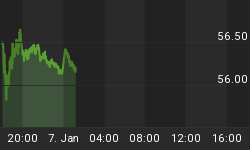The Fed's only concrete change in today's FOMC statement is the addition of the word "substantial" to its description of the cooling housing market. This is a resounding transition towards admitting the protracted slowdown in the housing market. It is one thing is for the markets and the Fed to notice the repercussions of the extended slowdown in housing. Yet it's another thing for the Fed to tell the market it is aware of the prolonged slowdown.
The other change in the statement is the way in which it communicated its assessment that GDP will return to trend growth. This time, it acknowledged that although "recent indicators have been mixed", it expects growth to progress at a moderating pace over coming quarters.
By making the word "substantial" as the sole change to its statement, the FOMC signals to the market that despite the slowdown in housing, it continues to describe "readings on core inflation have been elevated". This affirmation of inflation vigilance aims at preventing excessive downside in yields at a time when the core PCE price index remains at the top of the Fed's preferred range.
As in other Fed decisions, the prolonged FX effect of today's FOMC statement is expected to carry through the Asia's and Europe's Wednesday's sessions where traders will reintroduce a fresh negative bias on the US dollar. It is important to remind that the dollar was under pressure in Tuesday European trade on improved investor sentiment in Germany and higher than expected rise in UK CPI -- both credible reasons for keeping the door for further tightening by the BoE and the ECB. The dollar recovery was mainly due to squaring positions ahead of this afternoon's Fed decision.
We mentioned in Thursday morning's note (before payrolls) that that "Keeping fundamentals aside, we reiterate our short-term forecast for a rebound in the dollar, bond yields and a pullback in gold (until Tuesday's FOMC meeting.
We expect modest dollar declines in Wednesday's Asian session, with EURUSD testing the 1.3340-45 resistance, USDJPY revisiting 116.30 and GBPUSD eyeing 1.9750. FX may then stabilize ahead of Wednesday's release of the November retail sales, which are expected to show a notable rebound (+0.3% in both core and headline following -0.4%) due to pre-holiday related sales. It is this holiday effect, however, that will prevent the dollar from staging any substantial recovery from any strong figures.
"Substantial" makes Fridays' CPI extra crucial
In the event that Friday's release of the November core CPI remains below 0.2%, then we should expect sustain considerable dollar downside on the rationale that the Fed will shift its worry from the uncomfortable levels of inflation to the substantial housing slowdown. For this reason, the effect of the word "substantial" in today's statement will prolong into the rest of the year.
Finally, market emphasis will shift from Washington to Beijing as central bank rhetoric and currency diplomacy overlap during the china visit by Treasury Secretary Paulson and Fed Chairman Bernanke. There will be more on this point in our next note.
Do Falling US Imports Portend Broader Slowdown?
The bigger than expected 8.4% decline in the US October trade deficit to $58.9 bln, was the sharpest monthly decline in over 5 years. The trade imbalance was the lowest since August 2005. Imports of petroleum products fell 17% to $21.8 bln, the lowest level since July 2005. Notably, petroleum imports as a percentage of total imports eased to 14% from the 15.3% high attained in the past 2 months. But the improvement in the deficit is also a result of rising exports as these increased 2.2% to $123.6 bln, while total imports fell 2.7% to $182.5 bln.
Undoubtedly, the falling dollar and strengthening European economies are playing a major role in helping close the US trade gap. But it's also worth pointing that the decline in US imports isn't solely reflected in falling oil imports but also in a protracted retreat of demand for foreign goods. US imports of industrial supplies fell 5.9% to $48.5 bln in October, the lowest in 8 months. Whether the 17% decline in imports over the past 2 months is a reflection of an overall retreat in US demand requires further evidence. As the chart shows below, the last time industrial supply imports fell by such a sharp rate was during the 2001 recession.

The sharp retreat in the October trade gap could prop Q4 GDP by as much as 0.3%, further supporting prevailing expectations of a pickup in Q4 growth. But the optimistic take on the economy may well shed more attention to the imports story.















